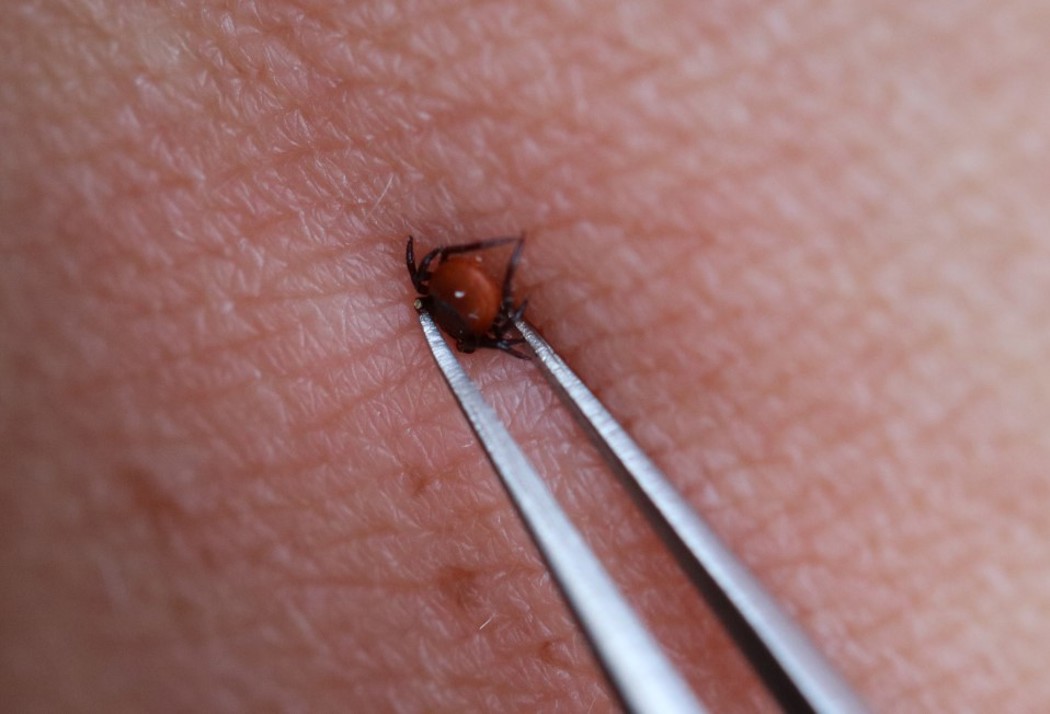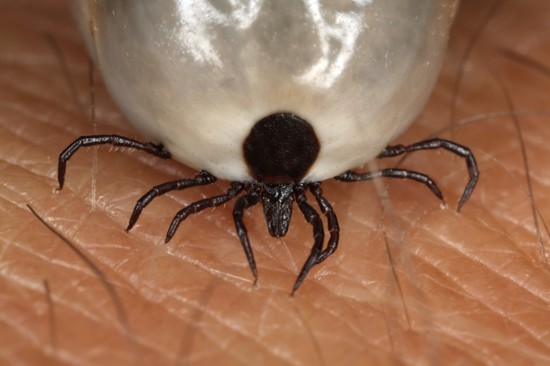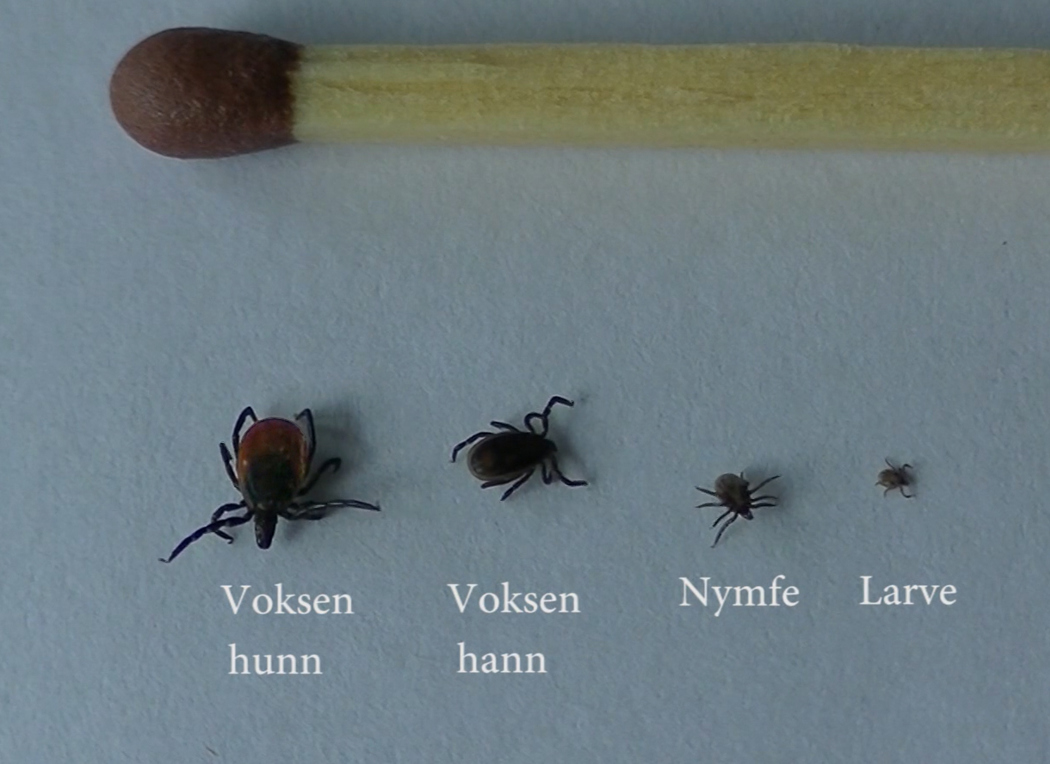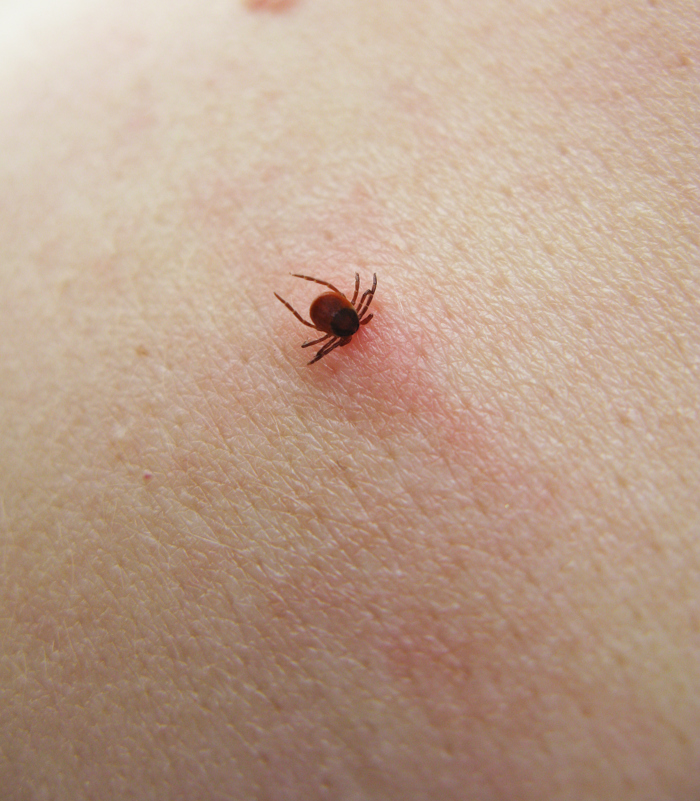How to avoid ticks
- Tuck long trousers into socks and use mosquito repellent to reduce the possibility of being bitten.Avoid walking through tall grass, heather and scrub in areas with a lot of ticks. Wear long trousers, cover your ankles and wear light-coloured clothing to make it easier to spot any ticks.
- Be aware that ticks can quickly crawl up the legs to the upper body, and can often find its way under clothing along the arms and around the neck.
- Use insect repellent containing DEET or Icaridin on clothing.
- You can reduce the risk of tick bites if you walk on paths rather than in places with tall grass, heather and scrub. It is important that you check for attached ticks after trips in tick areas. Ticks like to seek out hidden and thin-skinned places such as knees, groin, armpits and behind the ears, although they can be found elsewhere on the body.
- Clothes used on a trip should be shaken well, and they can be washed or hung outside. Ticks that enter the house will dry out within a few days
How to remove a tick
It is important to remove ticks as quickly as possible to reduce the risk of transmitting disease-causing microorganisms.
It is important to remove ticks as quickly as possible to reduce the risk of transmitting disease-causing microorganisms.
- Use tweezers or a tick remover to remove the tick.
- Grasp as close as possible to the skin and pull the tick straight out. Adult ticks that are firmly attached can be twisted slightly as they are pulled out.
- It does not matter if part of the biting apparatus remains in the skin. To prevent secondary infection at the bite site, apply an antiseptic ointment.

Grasp the inside of the skin with tweezers and pull the tick straight out. Adult ticks that are firmly attached can be twisted slightly as they are pulled out.
Illustration: FHI - Heidi Lindstedt
When should you contact a doctor?
Tick bites can cause a small swelling and a red mark a couple of centimetres wide around the bite, similar to a mosquito bite. This is harmless. However, if you develop a red rash that expands to a diameter of more than 5 cm around the bite, you should be on your guard. This could be Erythema migrans which is the most common symptom of Lyme disease. Consult a doctor if you develop such a rash. The rash, which may not be ring-shaped, can appear 3-30 days after a tick bite.
Also contact a doctor if, in the period after the tick bite, you:
- feel lethargic
- have a headache
- experience facial paralysis, muscle pain or fluid accumulation in joints
Remember that symptoms can vary with the type of disease and by the stage of the disease course. There is also a large variation from person to person.

Borreliose
Borreliose er en sykdom som spres av flått. Les mer om symptomer og behandling her.
Illustration: Johnér Bildbyrå AB
Ticks that spread infection and vaccine against tick-borne encephalitis (TBE)
The sheep tick is considered to be the worst disease-spreading vectors among the bloodsucking insects in Northern Europe and the most important diseases are Lyme borreliosis and tick-borne encephalitis (TBE). If ticks are removed within 24 hours, the risk of contracting Lyme disease is low. There is a vaccine against TBE. Talk to your doctor about vaccination if you are often bitten by ticks.
Other tick-borne diseases include anaplasmosis, rickettsiosis, neoehrlichiosis, tularemia and babesiosis.
Ticks on cats and dogs
Check dogs and cats daily in areas with ticks. Vets can dispense prescriptions for anti-tick products for use on dogs and cats.
Where do we find sheep ticks?
Sheep ticks are common along the coast of Norway from the Swedish border in Østfold up to Brønnøysund in Nordland. The northernmost place where we find viable populations of sheep ticks is Dønna, about 80 km north of Brønnøysund. Throughout this area there are high densities of ticks, but with large variations even over short distances. The density of ticks decreases rapidly as you move inland and in higher regions.
Ticks can be carried by birds and may appear far outside their core area. It is not unusual to find individual ticks far inland in Eastern Norway and in Northern Norway, north of the Arctic Circle.
The sheep tick is common throughout most of Europe. They are also found in mountain regions in North Africa and in south-west Russia, Kaukasus, Turkey and northern Kasakhstan.
Ticks thrive in damp grass, bushes and undergrowth
Ticks are vulnerable to drought. The greatest prevalence will be in damp places with grass, small bushes, scrub and in open forest with a good population of deer. In places where deer lie and rest, the number of ticks can be very high.
In Norway, the sheep tick is active when the air temperature is above freezing, the ground is no longer frozen, and the snow has melted. The number of ticks will often be experienced as highest in the spring. In midsummer, activity may decrease if it is very hot and dry.
Characteristics
The sheep tick has four stages of development: egg, larva, nymph and adult. The larva has only three pairs of legs but, apart from size, resembles nymphs and adults. Larvae are 0.5 mm long, nymphs are approximately 1.5 mm, adult males are 2-3 mm and adult females are 3-4 mm. The female is distinctive with a reddish-brown abdomen. When a tick is full of blood, the female may be up to 1.5 cm long, and the abdomen has a grey-blue colour.

Developmental stages – from right to left, larva, nymph and adult male and female.
Illustration: FHI - Heidi Lindstedt
Tick control
It is usually not possible to control ticks in the wild. Chemical control could have dramatic consequences for the environment.
You can reduce the occurrence of ticks by removing tall grass, bushes and undergrowth.
On some islands with a major tick problem, removing deer can help because they are hosts for adult ticks. This is usually only a temporary solution, as new deer quickly arrive on the islands.
